The best beginner drones for 2024: top flying cameras for new pilots
Earn your wings with the best beginner drones
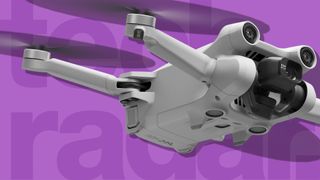
1. The list in brief
2. Best overall
3. Best budget
4. Best premium
5. Best DJI alternative
6. Best FPV
7. Best Mini 3 alternative
8. How to choose
9. How we test
For first-time flyers, the best beginner drones make it easy to airborne. From budget drones to accessible quadcopters, we've tested all of the top beginner drones. You'll find our favorites ranked in the the list below. Our expert guide will help you find the ideal starter drone, whatever your budget and piloting skills.
Based on extensive flying time, we think the best beginner drone overall is the DJI Mini 3. It doesn't have the collision avoidance sensors of the more expensive DJI Mini 4 Pro, but its combination of compact design, intuitive controls and automated shooting modes make the Mini 3 a fantastic tool for shooting easy aerial video. Or if you have a lower budget for your first drone, try the Ryze Tello: at just 80g, it's our favorite lightweight drone for novices.
Whether you're looking for a simple, affordable drone or something smarter to get you started, our round-up includes all of the best beginner drone options. If you're more confident at the controls, take a look at our pick of the best drones for every type of flyer.
To test the best beginner drones, our expert reviewers spend many hours flying them in the real world. We check a range of factors to determine which models are worth considering, such as battery life, stability and easy of use, as well as image quality and safety features. Our conclusions are summarized in the list below, together with useful buying advice to keep in mind when choosing your first drone.

Tim is TechRadar's Cameras editor, with over 15 years in the photo video industry and most of those in the world of tech journalism, Tim has developed a deeply technical knowledge and practical experience with all things camera related. He’s also worked in video production with clients including Canon, and volunteers his spare time to consult a non-profit, diverse stories team based in Nairobi.
The quick list
If you’re ready to get off the ground, the summary below will give you an instant overview of the top beginner drones. If you land on one which suits your needs and budget, you can use the links to fly down to our full write-ups.
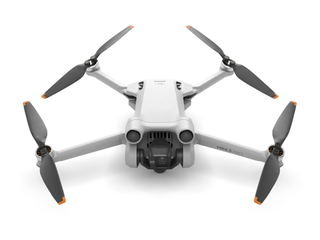
The best beginner drone overall
With a lightweight folding design, intuitive controls and a sensor that captures great images, the DJI Mini 3 offers top value for novice drone pilots.
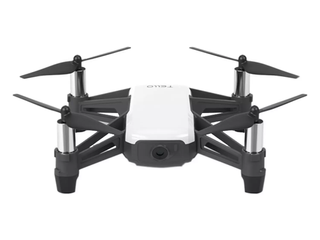
The best budget beginner drone
An affordable flyer with a tiny design, the Ryze Tello is a top choice for beginners who want a cheap drone for learning the basics, even if it drifts in wind.
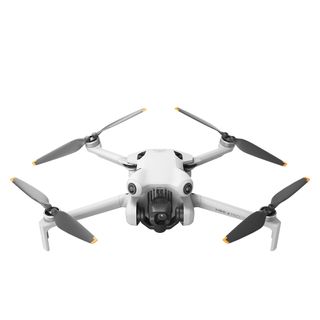
The best premium beginner drone
If you’re a beginner with a bigger budget, the DJI Mini 4 Pro is the undisputed sub-250g drone, with incredible flight and safety features.
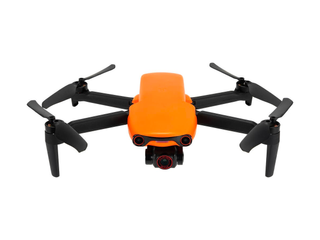
The best beginner DJI alternative
If you’re looking for something different to DJI drones, the Autel Eco Nano+ is an impressive beginner drone with a big sensor and collision detection.
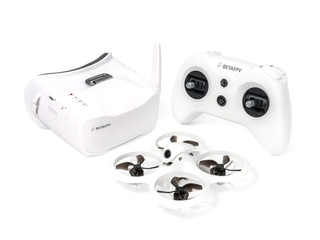
The best beginner FPV drone
A complete FPV drone kit, we think the BetaFPV Cetus X is the best choice for beginners who want to experience the fun of first-person flight.
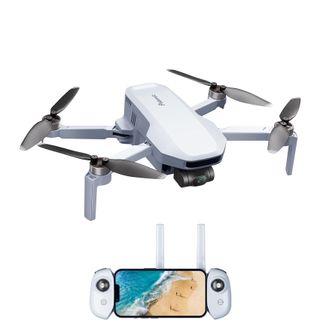
The best DJI Mini 3 alternative
An affordable alternative to our favorite drone, the 3-axis mechanically stabilized 4K Potensic Atom offers plenty of bang for your buck.
The best beginner drones in 2024
Why you can trust TechRadar
Below you'll find full write-ups for each of the best beginner drones in our list. We've tested each one extensively, so you can be sure that our recommendations can be trusted.
The best beginner drone overall
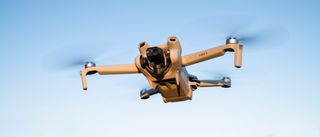
Specifications
Reasons to buy
Reasons to avoid
✅ You want a cheap second drone: If would like a smaller and lighter drone with fewer flight restrictions than a larger drone, the Mini 3 is a great option.
✅ You want aerial photos: Image quality is identical to the more expensive Mini 3 Pro, so you won’t outgrow the capabilities of the Mini 3 too soon.
❌ You want collision avoidance: For peace of mind when flying your drone close to trees and in more complex environments, you'll need to spend more.
❌ You fly in windy weather: The Mini 3 can in theory fly in wind up to 24mph, but not easily and it'll struggle and drift.
DJI’s latest compact drone lands as the best edition for beginners yet. Like both of its Mini predecessors, the DJI Mini 3 is a lightweight flying machine with a small folding body, intuitive controls and useful automated filming modes. Like those same predecessors, it still misses out on collision avoidance – something you only get by spending more on the Pro version. But it proved every bit the quality drone in testing: we found it forgiving to pilot using the standard controller, which is the same as the one supplied with the Mini 2. Drift was only an issue in the windiest conditions.
While it lacks the Log profiles of DJI’s premium drones, we found that its 1/1.3-inch sensor – larger than the DJI Mini 2’s – captured sharp 4K/30p footage that was excellent overall. What also set it apart was the ability to rotate its 12MP sensor to portrait for shooting social content. If you already have a DJI Mini 2, the case for upgrading is less compelling. But if you’re shopping for a well-built and feature-packed beginner drone, this is the best you can get.
Read our in-depth DJI Mini 3 review
The best budget beginner drone
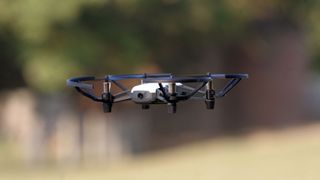
Specifications
Reasons to buy
Reasons to avoid
✅ You're getting started: The simple app and responsive controls help you master basic flight manoeuvres, take-offs and landings.
✅ You’re an indoor pilot: With rotor guards and stability sensors, the Tello is safe and easy to fly inside.
❌ You want decent quality video: The Tello is limited to choppy and compressed 720p videos.
❌ You want to go far: The Tello has a low range and restricted altitude and so it can't fly far or high.
Designed in partnership with DJI, the Ryze Tello is an affordable, featherweight drone that’s great for mastering the basics of flight. It can be controlled via the Tello smartphone app and Wi-Fi, but you can also use a Bluetooth gaming controller – albeit at a shorter range. It proved to be a responsive and lively flier during our tests, which makes it an effective way to master the ups and downs of quadcopter flying.
It’s not all positive. The flight range is limited (well below the 100m maximum Ryze suggests, think 30m instead), while the slightest breeze will send the drone drifting off in whatever direction it’s blowing. The 720p video camera isn’t up to much either, and with no local storage it sends all footage and photos directly to your phone – which results in choppy video if and when the Wi-Fi connection dips in and out.
Those caveats aside, the Tello is a great starter drone that does the simple things well and feels better made than other budget models. It's the obvious pick for the best budget beginner drone category.
Read our in-depth Ryze Tello review
The best premium beginner drone
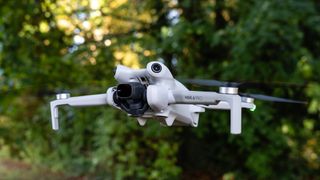
Specifications
Reasons to buy
Reasons to avoid
✅ You’re a pro drone pilot looking for a second drone: The Mini 4 Pro's D-Log M color profile matches the look in pro models from the Mavic 3 series, making it a great sub-250g second drone.
✅ You want a premium sub-250g drone: With excellent image quality, flight features and safety features, there's currently no better sub-250g drone available.
❌ You’re a happy Mini 3 Pro owner: While the Mini 4 Pro's new features are impressive, they won’t justify an upgrade for many.
❌ Omnidirectional Obstacle Avoidance is overkill: If you're unlikely to fly in complex environments you could opt for the DJI Mini 3 Pro instead – it's tri-directional obstacle avoidance is sufficient already.
Succeeding the Mini 3 Pro – our previous favorite premium beginner drone – the Mini 4 Pro is an incremental upgrade that uses the same f/1.7 aperture camera and 1/1.3-inch sensor. From our tests, it produces excellent quality 12MP / 48MP images in raw and JPEG, with very little noise up to its maximum ISO 6400 setting. Filmmakers enjoy a couple of improvements, though, including 4K video now up to 100fps, plus D-Log M color profile that makes the Mini 4 Pro an enticing option as a second drone to a pro-level Mavic 3-series model, where color consistency is easily achieved.
Any disappointment over the perceived lack of camera improvements should be quelled by the Mini 4 Pro's flight and safety features. The Mini 4 Pro boasts Omni Directional Obstacle Avoidance (the Mini 3 Pro has tri-directional obstacle avoidance), improved subject tracking performance, plus a more extensive transmission range, up to 20km depending on your region and what's legally possible. This sub-250g drone is another level to all of the other drones in this guide, and it's so good it'll have you wondering if you need to register a drone again.
Read our in-depth DJI Mini 4 Pro review
The best DJI alternative for beginners
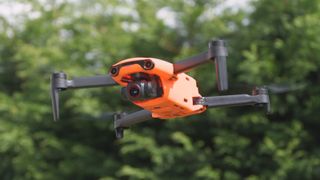
Specifications
Reasons to buy
Reasons to avoid
✅ You’d rather avoid DJI: The Autel Evo Nano+ is the competition that DJI needs.
✅ You like low-light photography: The image quality from this drone beats the DJI Mini 3.
❌ You use third-party applications: Currently, Autel doesn’t offer an API to allow external companies to develop software tools for their drones.
❌ You fly in windy conditions: Despite the same Level 5 wind resistance performance varies, and we’d place the Nano+ closer to the Mini 3, but behind the Mini 4 Pro.
The Autel Evo Nano+ is taking on DJI's Mini 4 Pro in the sub-250g drone category. That is no easy undertaking, with the latter being so close to perfect. But to its credit, the Evo Nano+ is an impressive beginner drone in its own right.
During our tests, we've found that its sensor surpasses our current top pick for beginners, the DJI Mini 3, when it comes to low-light performance. It's just about on par when dealing with windy conditions, too. That makes it an easy recommendation for us, especially if you love capturing sunsets and twilight cityscapes – not to mention if you need a high-performance drone that meets Europe's critical weight limits.
Admittedly, the Mini 4 Pro has the overall edge here. However, the Evo Nano+ should see refinements over time, thanks to Autel's adding new features and making improvements via firmware updates. And, if you're looking for an ace alternative to DJI's offerings, this one should be at the top of your list.
Read our in-depth Autel Evo Nano+ review
The best beginner FPV drone
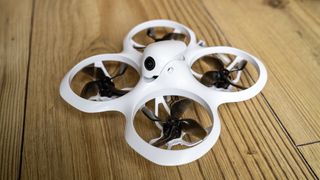
Specifications
Reasons to buy
Reasons to avoid
✅ You want to try out FPV flying: This is the ready-to-fly FPV kit for those looking to try their wings.
✅ You want a high octaine drone experience: Once you get to grips especially with the Manual/Acro mode, FPV drones are hugely fun and exciting.
❌ You want to take aerial photos: FPV drones are primarily for flying and not photography.
❌ You get motion sick: If you typically suffer from motion sickness, FPV drones in general might not be for you.
If you want to try flying an FPV drone, we think the BetaFPV Cetus X Kit is a top choice. As a package, it comes with everything you need for first-person flight, including a transmitter and a basic set of goggles. More powerful than models like the Cetus Pro, we found that its multiple flight modes and speed settings also make it an FPV drone you can grow with.
During our review, it took time and patience to master the Manual/Acro mode. Crashes are also inevitable, and while the frame is built to withstand impacts, it did crack in our tests. Still, provided you have the stomach to stick it out without succumbing to motion sickness, the Cetus X will reward you with an immersive flying experience.
We did find the video feed prone to break-up and interference, and while a built-in DVR can record flight feeds, this isn’t a drone for stills photography. Battery life was also a disappointment, rated at just five minutes. But with enough power to perform simple freestyle tricks and everything in the box to get airborne, this is our favorite FPV kit for first-timers.
Read our in-depth BetaFPV Cetus X review
The best DJI Mini 3 alternative
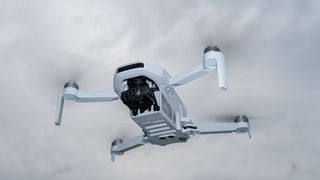
Specifications
Reasons to buy
Reasons to avoid
✅ You want control of the camera: Beginner drones don't usually offer manual camera control and the ability to capture photos in raw format, but the Atom bucks this trend.
✅ You want stable videos: A 3-axis mechanical gimbal that stabilizes 4K 30fps video, in a fly more drone combo kit costing less than $400 / £400 / AU$700? Yes please.
❌ You want decent safety features: If you want the safety net that obstacle avoidance affords, you’ll have to fork out extra for a pricier alternative.
❌ You shoot video in bright light: Without ND filters it’s impossible to achieve the correct exposure and 180-degree shutter rule in bright conditions.
Not to be confused with the Potensic Atom SE, the newer Atom comes a year later and addresses the Atom SE's shortcomings and sits somewhere between the DJI Mini 2 SE and the DJI Mini 3. It's a fanstastic beginner drone that our review says, "offers a performance that belies its low cost"; cheaper than the Mini 3, the Atom costs less than $400 / £400 / AU$700 in a fly more combo kit that adds two additional batteries, a fast-charging hub with a power adaptor and carry case in addition to the generous accessories that come in the standard kit.
The Atom's highlights include manual camera control, raw 12MP photos, 4K video up to 30fps and a mechanical 3-axis gimbal; all of these features are rare in a beginner drone at this price level. The mechanical gimbal gives smoother video footage than the Atom SE, while also enjoyed the improved GPS accuracy and intelligent flight features including subject tracking. The Atom drone isn't perfect; its lens focus is fixed, there's no obstacle avoidance (which you don't get at this price point), nor are there ND filters available to regulate shutter speed for video in bright light. However, Potensic's best-ever drone is fantastic value and a true DJI alternative.
Read our in-depth Potensic Atom review
How to choose the best beginner drone
What are the best beginner drone features?
Beginner drones come in a range of shapes and sizes, but the best models all share a few key features. If you’re just starting out, then a slick companion app will be invaluable – some of the best we’ve tried are from DJI, Ryze and FIMI. A drone that’s happy to hover in place will also allow you to carefully learn the controls and understand how sensitive it is to commands. A few of the drones above, such as the DJI Mini 3, also feature preset flying tricks that allow you to easily capture Hollywood-style shots, which can produce impressive results with just a little bit of practice.
What’s the best beginner drone for videography?
If you’re looking for a beginner drone with a camera, then bear in mind that you’ll need to spend a bit more to get genuinely usable footage. Look for a drone with a camera that has at least a 1080/30p mode. A low-resolution sensor like the 720p one found on the Ryze Tello is fine for learning the basics, but you’ll need to spend at least $350 / £300 / AU$550 to get a really high-quality camera, such as the 4K recorder on the DJI Mini 3.
What’s the best beginner outdoor drone?
It’s important to think about where you’re most likely to fly your drone. If you’re happy to stay indoors or in sheltered spots near your home, then a small, toy model (like the Ryze Tello or Revell Icon) will be fine. But for more ambitious flights, you’ll need a drone that can withstand gusts of wind and a few crash landings, like the DJI Mini 3. Drones with obstacle avoidance sensors, such as the DJI Mini 3 Pro, are the safest to fly outdoors, but these usually come at a premium.
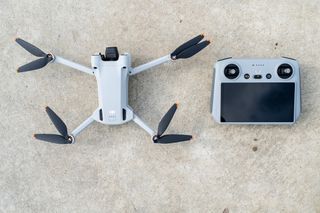
Do I need a license to fly a drone?
Drone laws mean that taking to the sky is tightly regulated. This is to ensure that the skies remain safe for everyone, especially around sensitive locations such as airports and national parks. Drone laws also try to address privacy concerns when camera-equipped drones fly in residential areas.
In many regions, like the US, drones that weigh below 250g do not need to be registered with a civil aviation authority. You'll still need to follow all the local drone laws, such as keeping your drone within line of sight at all time, but registration commonly isn't required.
This isn't the case in all countries, though. In the UK, drones weighing less than 250g used to be exempt from registration requirements. This has now changed, so that owners of any drone with a camera will need to register their flying machine with the Civil Aviation Authority and get an Operator ID. You can do this for a fee of £9 per year, provided you’re 18 or over.
If your drone weighs more than 250g, you’ll also need a Flyer ID. To get this, you’ll need to take an online test consisting of 40 multiple-choice questions. The answers can all be found in the Drone Code and should help to ensure that you’re a safer flyer.
If your drone weighs less than 250g and does not have a camera, you won’t need either ID. But you’ll still need to check that you’re piloting your drone in line with the UK’s drone laws. According to the Drone Code, that means keeping eyes on your drone at all times, not flying higher than 120m above the ground and staying at least 150m away from built-up areas. And you’ll need to avoid restricted airspace, which is usually around airports.
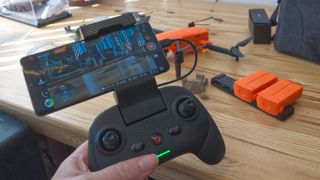
How we test beginner drones
When it comes to beginner drones, their usability and flying importance is just as important as their cameras – so we place equal emphasis on both during our testing.
To test the former, we run through their stabilization in the air, overall responsiveness and their top speed. Most beginner drones lack obstacle avoidance powers, but if they do have them we fly them though an obstacle course to see how well they work.
After checking the drone's battery life claims based on real-world flights, we then move onto their cameras. Most beginner drones have small sensors that struggle in high-contrast situations, but we fly them through a variety of lighting conditions to see where their breaking point is and in what conditions you can realistically expect usable footage.
We then evaluate their footage, taken at a range of frame-rates, on a calibrated monitor, alongside some of the drone's sample still photos. When it comes to image quality, we look at detail, sharpness across the frame, and high ISO noise handling. We then combine these results with our overall impression of the drone's design, features and value to produce our final verdict.
Get daily insight, inspiration and deals in your inbox
Get the hottest deals available in your inbox plus news, reviews, opinion, analysis and more from the TechRadar team.

Tim is the Cameras editor at TechRadar. He has enjoyed more than 15 years in the photo video industry with most of those in the world of tech journalism. During his time as Deputy Technical Editor with Amateur Photographer, as a freelancer and consequently editor at Tech Radar, Tim has developed a deeply technical knowledge and practical experience with cameras, educating others through news, reviews and features. He’s also worked in video production for Studio 44 with clients including Canon, and volunteers his spare time to consult a non-profit, diverse stories team based in Nairobi. Tim is curious, a keen creative, avid footballer and runner, and moderate flat white drinker who has lived in Kenya and believes we have much to enjoy and learn from each other.
- Chris Rowlands
- Michelle Rae UyContributor
